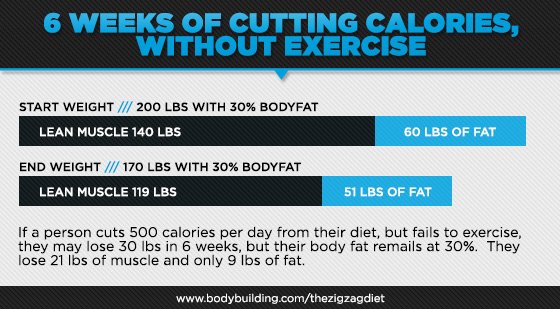Convention has it that there are three ways to lose weight: 1) dehydration, 2) fat loss, and 3) lean muscle weight loss. Fat loss is the ONLY acceptable route for you. Dehydration is never healthy or acceptable, and losing lean muscle is totally counter to everything that a healthy, fitness-oriented lifestyle stands for.
According to the same conventional wisdom, fat loss can only be accomplished three ways:
- With aerobic exercise
- Through reduced caloric intake
- Through a combination of the two
There are many ways that fat can be shed. All, to date, suffer from the same persistent problem. How do you lose fat without also losing muscle? See, conventional wisdom is just that—conventional. Losing fat and gaining muscle requires an UN-conventional approach. Since I'm sort of an unconventional guy, I took a look at the problem, and conducted some research which proved rather groundbreaking in the results I achieved. So how do you lose fat and GAIN muscle?
Don't tell me, "Why with heavy weight training!" I know better, and so do the dozens of legitimate researchers who have tried and tried to find an answer short of drugs. And, PLEASE! Disregard all of the magazine ads that claim to have done it. They haven't, and I know it! Certainly not I the (say) under six weeks that some claim, and certainly not to the extent that some claim. Check the research.

You'll see that weight training (bodybuilding) while on a calorie-restricted diet is capable of reducing muscle loss, and perhaps (among severely detrained couch potatoes) reverse the effect of disuse by adding a couple of pounds of muscle initially, but losing it during the ensuing weeks of sub-1000 calories per day dieting.
To illustrate, just picture any bodybuilder in the final stages of contest preparation. They look in the mirror two weeks out (all of them do), they don't see all the striations they think they should have, and they freak. They amplify their aerobic work to levels beyond reason and reduce their fat and carb intake to sub-survival levels. They lose 15 pounds of muscle in the last two weeks in order to lose one lousy pound of fat. All of them do it, always have. What's startling is that many of them lose muscle despite being on anabolic steroids!
Is there a way to lose fat and, at the same time, increase the amount of muscle tissue you have? Not just for contest bodybuilders, but anyone? Fitness enthusiasts? Athletes trying to make weight? Even grossly fat people who have never trained before? Yes, so read on. First, let's explore some of the reasons why diets have almost always failed in the past.
Why Do Diets Fail
The United States Food and Drug Administration (FDA) has come down hard on the weight loss moguls because of their false claims of providing you with permanent weight loss. The FDA has done so because 95 percent of the people who buy into the popular weight loss programs on the market today end up gaining all of the weight back (and usually more) within a year or two.
Why is this so? No fat-loss plan fits everyone. During the past 50 years there have been literally hundreds of weight loss strategies recorded or marketed in this country. This remarkable statistic gives vivid testament to the "thin is in" mentality most Americans have grown to espouse. And it's good that we feel this way. Most of us are painfully aware of the health risks associated with obesity, and woefully ignorant of how to avoid it. Of course, in bodybuilding an other sports, fat loss is elemental to improved performance.
Almost all of the weight loss strategies used thus far fall into the following categories:
- Medical (drugs) therapies
- Psychological strategies
- Nutritional supplements
- Food (diet) manipulation
- Surgical techniques
- Exercise techniques
- Calorie restriction
- Various therapeutic modalities
The truth be known: NONE has worked on a permanent basis.
None of the weight loss moguls has ever tried to personalize everyone's fat loss strategy because it would be cost-prohibitive. Despite what the weight loss marketeers may have thought in the past, personalizing your approach is crucial to the success of your fat-loss efforts. The answer lies in taking an integrated approach, with each element uniquely matched to your specific situation:
The answer lies in taking an integrated approach:
- Genetic (hereditary) factors
- Your unique biochemistry
- Your current state of health
- The environment you live in
- Your current level of fitness
- Personal lifestyle considerations
- Your medical history
- Your unique metabolism
- Your financial status
- Your tastes in foods
- Your unique psychology
These are the ever-changing elements which in large part determine the permanency and effectiveness of your fat loss efforts. It's clear that most of these factors are inextricably interrelated. But how do you manipulate genetics? How do you augment your metabolism? How do you account for something as complex as your biochemical makeup? Part of the answer lies in understanding the nature of obesity.
What Causes Obesity?
What made you fat in the first place? In most people's cases it's pure slovenliness. There are many other causes too. In particular, the Traditional Chinese Medical [TCM] view is interesting.
The ancient Chinese—always inscrutable—have been observing and recording the symptoms of obesity for hundreds of years. They watch skin color, the color of your stool, your tongue, how you feel, your breathing, and dozens of other symptoms, recording for hundreds of years. These symptoms cluster into three distinct varieties of obesity. These observations and recommended treatments were recently put to a test at Xi Yuan Hospital in China. Xi Yuan Hospital is the headquarters of the China Academy of Traditional Chinese Medicine.
Based on the clinical manifestations recorded by the Ancients, the researchers at Xi Yuan Hospital were able to treat obesity—on a permanent basis—in 80 percent of the cases. Compare that astounding success rate with this country's industry standard of a 95 percent failure rate! Now, let's get back to shedding blubber and donning meat.
The Zigzag Diet Plan
Okay. Let me hit you right between the eyes up front. The answer is so simple, yet I've never in all my years of being in this business, heard anyone utter it. I claim it. Here it is:
- You can't lose fat unless you're on a negative calorie balance diet.
- You can't gain muscle tissue unless you're on a positive calorie balanced diet.
- You can't lose fat and gain muscle unless you alternate periods of negative calorie balance with periods of positive calorie balance.
- It doesn't matter if you're trying to lose total body weight, stay at the same total body weight or gain total body weight. The zigzag rule applies to everyone. All the time.
The process if zigzagging is actually integrated into a more comprehensive plan which accounts for the factors noted earlier regarding personalizing and integrating your training efforts. There are five rules to the process, and they apply to everryone on Mother Earth, from cradle to grave:
The 5 Rules
Rule 1
 Always eat at least 5 meals a day (preferably 6 or 7). Two or three meals simply isn't often enough. Your blood sugar levels will be controlled (and thus your cravings), you'll get protein in small amounts throughout the day to support growth and recovery, and (most important) the enzymes that store fat will be produced in far smaller amounts, making your body far less capable of storing fat!
Always eat at least 5 meals a day (preferably 6 or 7). Two or three meals simply isn't often enough. Your blood sugar levels will be controlled (and thus your cravings), you'll get protein in small amounts throughout the day to support growth and recovery, and (most important) the enzymes that store fat will be produced in far smaller amounts, making your body far less capable of storing fat!
Simply, by providing your body with a consistent and frequent supply of calories—life-giving energy—its need to store fat is significantly reduced. Conversely, when you eat infrequently, your body recognizes a "famine" situation, and the enzymes are produced in large quantities to "swoop down" on every calorie you consume in order to store it as fat in preparation for the "famine" to come.
Rule 2
Remember the 1-2-3 rule. In each of your 5 meals, approximately 1 part of the calories should come from fats, 2 parts from protein and 3 parts from carbohydrates. This is a guideline, not a hard-and-fast law. Just keep the fat intake down to a low level (do not eliminate fat, as some fat is essential for maintaining good health), consume enough protein to support growth and recovery, and carbohydrates commensurable to your energy output (carbs are your body's preferred energy fuel source). Remember that protein and carbohydrates both have 4 calories per gram, while fat has 9 calories per gram.
Rule 3
When you sit down to eat, ask yourself, "What am I going to be doing for the next three hours of my life?" Then, if you're taking a nap, eat less than the average amount of carbs; if you're planning on being active, eat more than the average amount of carbs. For average between-meal activities, eat an average sized meal. Always keep your protein intake up to an appropriate level. This simple system ensures that you'll never put fat on from eating excess calories, or cannibalize your muscles from eating too little.
Rule 4
Another thing to remember whether you're trying to lose fat or adding lean muscle is to "zigzag" your caloric intake. For example, if you want to lose fat, reduce your calories during the week, but "pig out" on Friday night and Saturday. This will 1) readjust your BMR upward, 2) support lean tissue building, and 3) give you a psychological "lift." Remember, in Rule One you learned that your fat storing enzymes were no longer a threat, so you can pig out once in awhile! In fact, if you want to put on lean muscle, you must! There is no way you can maximize lean muscle mass while on a calorie-restricted diet.
Rule 5
Your reduced intake of calories makes it almost impossible to get all of the nutrients your body needs to remain healthy and active. So, it's important to supplement your diet with vitamins, minerals and other carefully selected substances to ensure maximum progress toward your fitness, health and fat loss goals. Also, no matter how hard you try, no matter how good of a cook you are, or where you buy your food:
Why Supplement?
- You can't always eat 5 or 6 times daily;
- There are many instances where your body either requires or can make good use of certain nutrients in greater amounts than what can be derived from Mother Nature alone;
- A perfectly balanced diet cannot be maintained during periods of contest preparation or periods where there is a purposeful caloric restriction imposed;
- Periods of high-stress training require super normal intake of many nutrients without a commensurable increase in caloric need;
- Periods of high-stress training creates a situation in which various benefits can be derived from nutritional substances not normally found in food or biosynthesized in the body in sufficient or significant quantities but which are either man made or derived from botanical sources;
- Soil depletion, toxins in the food chain, overprocessing, overcooking, free radical formation in the body, and a host of other (sometimes medically related) factors all interact to make food less than totally nutritious.
- Because man has been able to improve on Mother Nature's original work in many of life's arenas, there are some "superfoods" available which are plain and simply BETTER than the normal diet for serious fitness training.
So, you MUST use nutritional supplements!
Where Your Calories Come From?
- 1 gram of fat equals 9 calories.
- 1 gram of protein equals 4 calories.
- 1 gram of carbohydrates equals 4 calories.
- It's clear that you should reduce your consumption of fat in order to decrease your body fat level, because fat is a highly concentrated source of calories.
- It's also clear that in order to gain muscle weight, you must reduce your consumption of fat in favor of more protein, because 1) fat can't become muscle, and 2) only protein can.
Will Cutting Calories Result In Fat Loss?
There are 3,500 calories in one pound of fat. That means that by reducing your food by 500 calories per day, you should lose one pound of fat per week, right? Wrong! Actually, much of the weight you'll lose will come from muscle tissue, not fat! Why? Because your body tends to use ("excess") muscle tissue for needed energy before it reclaims fat deposits.
The answer is to take your time with fat loss, and either preserve or build muscle tissue by integrating scientific weight training, mild aerobics, dietary manipulation, supplementation and other technologies into your lifestyle. Follow the rules above!

This poor soul actually lost 21 pounds of muscle and only 9 pounds of fat! He'll yo-yo back up to 200 in no time (within 1-2 years according to information compiled during the Congressional investigation into the fat loss industry). However, in doing so, he or she will be 35 percent body fat instead of their original 30 percent. Why? They never regained all of the lean tissue they lost as a result of their crash dieting earlier.
NEVER attempt to gain or lose "weight!"
Instead, you should always strive to gain muscle and lose fat!
To Gain Muscular Weight
- Add 2 calories per pound of body weight to your daily caloric intake.
- The added calories should be mostly protein and some complex carbohydrates (no added fat calories).
- Spread these added calories equally among 5 meals per day.
- For example, a 150 pound person should add 300 calories per day to their diet; over 5 meals, that equals about a 60 calorie increase per meal.
- The additional 300 calories will, with intense weight training, result in a gain of approximately 1-2 pounds of added muscle per month.
- Reduce your caloric intake two days per week by 2 calories per pound of body weight, to ensure that excess fat is being removed (called "zigzag dieting").
To Lose Fat Weight
- Subtract 2 calories per pound of body weight from your daily caloric intake.
- The reduced calories should come mostly from fat calories, and NOT protein.
- This caloric reduction should be applied to all of your 5 meals; NEVER skip meals!
- For example, assuming that you weight 150 pounds, and you're eating 5 meals per day (highly recommended), you should reduce each meal by 60 calories (total of 300 calories reduction over a full day).
- By reducing your daily caloric intake by 300 calories, you can expect to lose about 2 1/2 pounds of fat per month, assuming you're weight training for muscle mass preservation or increase.
- Increase your caloric intake two days per week by 2 calories per pound of body weight, to ensure that you're getting enough calories to put on lean muscle, and that upward BMR adjustments are being made (called "zigzag dieting").
Maintain Weight But Become More Muscular
- Follow the rules listed above, with the exception that your intake of calories remain equal to your daily energy expenditure (see calorie table in preceding pages).
- Alter your ratio of nutrients so that protein is maximized and fat is minimized.
- Carefully control your calories on a meal-per-meal basis, ensuring that you consume only enough calories to get you to your next meal (no more and no less). You never eat for what you just did, ONLY for what you're about to do.
- Over the course of 6 months or so, this sort of fastidiousness will pay off with big dividends in more muscle tissue and less fat—you'll begin to look and feel great!
Activities And Calories Expenditure
Approximate Hourly Caloric Cost For Different Body Weights
 The caloric expenditures listed are for people with about a 20 percent body fat level. The smaller your muscles are, the fewer calories you'll burn; the bigger your muscles are, the more calories you'll burn. But remember that strenuous exercises with weights (including, but not limited to, dumbbells and barbells, Nautilus-type machines, your own body weight, and other forms of resistance exercises) is the best way to increase your muscle size, thereby increasing your metabolic rate. This will result in far more calories being burned all day long—even at night while you're sleeping.
The caloric expenditures listed are for people with about a 20 percent body fat level. The smaller your muscles are, the fewer calories you'll burn; the bigger your muscles are, the more calories you'll burn. But remember that strenuous exercises with weights (including, but not limited to, dumbbells and barbells, Nautilus-type machines, your own body weight, and other forms of resistance exercises) is the best way to increase your muscle size, thereby increasing your metabolic rate. This will result in far more calories being burned all day long—even at night while you're sleeping.
Remember that all forms of exercise result in sweating. So, drink at least eight full glasses of water daily.
Aerobic Training For Fat Loss
"Aerobic" means "with oxygen." So, aerobic dance, step aerobics, Stairmaster training, bicycle ergometer training and the host of other low impact, high heart rate methods of training are all geared to make your body use more oxygen.
Why would you want to use more oxygen? Simply, it's 1) good for the heart muscle, 2) it's the ONLY way your body can burn fat for energy, and 3) it's good for longevity. Beware, however! Aerobic training doesn't build muscle to any significant degree. And, since only muscle burns calories, you want more muscle far more than you want an aerobic capacity which rivals that of an elite marathon runner. Remember, the fat control strategy of choice is ALWAYS going to be to maintain a reasonable level of muscle mass so you can burn calories (and fat) all day long—not just during aerobic training.
Research clearly shows that in order to maintain a reasonable aerobic capacity, you should train at about 60-80 percent of your maximum heart rate for about 30 minutes three times weekly. More than that, and you're probably training aerobically more than you need to.
Weight Training For Fat Loss
Weight training—often referred to as "resistance training"—has one key advantage which is present only minimally in other forms of exercise. It builds muscle. Weight training involves reversing the effects of the years of disuse your body has just undergone from inactivity. Even mild weight training will result in muscular growth. Bigger muscles burn more calories than smaller ones. They also look better.
Note that "reversing the effects of disuse" means just that. It does not necessarily mean becoming huge or looking like Arnold Schwarzenegger!
There are many excellent systems of weight training. Perhaps the best one for beginners interested in getting rid of unwanted fat and improving general tone and fitness is the "circuit training" system. The great thing about this system is that you needn't belong to a gym or club to do it! You can easily perform this system of resistance training in your home.
The main objective of circuit training is completing all of the "stations" in the circuit in decreased time. Each station consists of one weight training exercise per body part.
One complete circuit for a total-body workout may look like this:
Cross-Training
Common misuse of the term "cross-training" has limited its definition to aerobic-type activities (e.g., triathlon competition, wherein swimming, cycling and running long distances comprise the "cross-training" event). This is not cross-training in the scientific sense of the term.
So, let's set the record straight once and for all. The definition of cross-training will, from now on, be expanded to incorporate any form(s) of training designed to take you through the ATP/CP pathway of muscular energetics, through the glycolytic pathway of muscular energetics, on into the aerobic (oxidative) pathway of muscular energetics.
ATP/CP training is explosive, short-duration types of movement such as powerlifting, throwing, sprinting or shot-putting.
Glycolytic training involves pushing your anaerobic threshold with such activities as running 400-800 meters for time, forcing those last four or five reps out of each set in weight training, or playing an extremely fast-paced game of racquetball. And, aerobic training involves pushing your oxidative capacity to the limit through high intensity long-distance running, swimming or cycling.
Then you put 'em all together. That is cross-training!
For general fitness, it's great. It'll provide a good level of fitness across the anaerobic-aerobic continuum.
For elite athletes, well, stick to your sport's requirements and you'll do much better. Athletes must convert their bodies into highly specialized "machines" that are capable of performing their sport to the utmost limits of human tolerances. All serious athletes must specialize!

* Athletes in the heavier weight divisions typically exceed these guidelines by 3-4 percentage points; to exceed them by more than this margin is pure and simple "slovenliness."
** Elite male bodybuilders are usually closer to the 8 percent level as opposed to the 4 percent level because (it's believed) they've put on extra "mass" via fat deposits in the muscles themselves. Their subcutaneous fat levels, however, remain extremely low in order to show "cuts" (muscular definition).